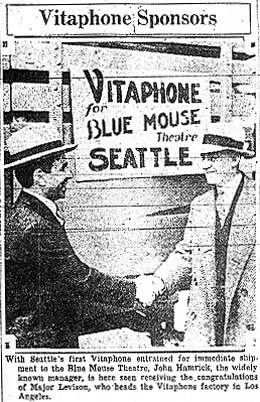On March 18, 1927, sound motion pictures debut in Seattle at the Blue Mouse Theater, 1421 5th Avenue. Warner Bros.' Don Juan, starring John Barrymore (1882-1942), features a musical score and sound effects, but no dialogue, using a phonograph record synchronized with the film in a process called Vitaphone.
Vitaphone was developed by the Western Electric Co. and used a 16-inch disc rotating at 33 1/3 rpms. Sound was reproduced in the theater with moving-coil type loudspeakers. The process was introduced to Seattle by manager John Hamrick (1876-1956), a local exhibitor who owned movie houses throughout the Pacific Northwest, including sister Blue Mouse theaters in Portland, Tacoma, and Spokane.
Preceding the main feature were a speech by Will H. Hays (1879-1954), president of the Motion Picture Producers and Distributors of America; a musical number by Roy Smeck; a quartet singing "The Volga Boatmen"; and Giovanni Martinelli of the Metropolitan Opera accompanied by the New York Philharmonic Orchestra. Music for Don Juan was also performed by the New York Philharmonic, a technological advance that would eventually put thousands of in-house theater musicians out of work on the eve of the Great Depression.
Calling the synchronization of sight and sound “uncanny,” Everhardt Armstrong of the Post-Intelligencer was quite impressed with the Vitaphone, as were others who attended the new show at the Blue Mouse. “Throughout the Barrymore picture ... the orchestral accompaniment follows closely, and without a break, the emotional curves of the story,” he remarked. “And the music is so amplified by Vitaphone as to be heard with equal clarity from every seat in the theatre” (“Vitaphone is Triumph at Blue Mouse”).
Vitaphone was eventually replaced by sound-on-film technology, which quickly became the Hollywood standard.

